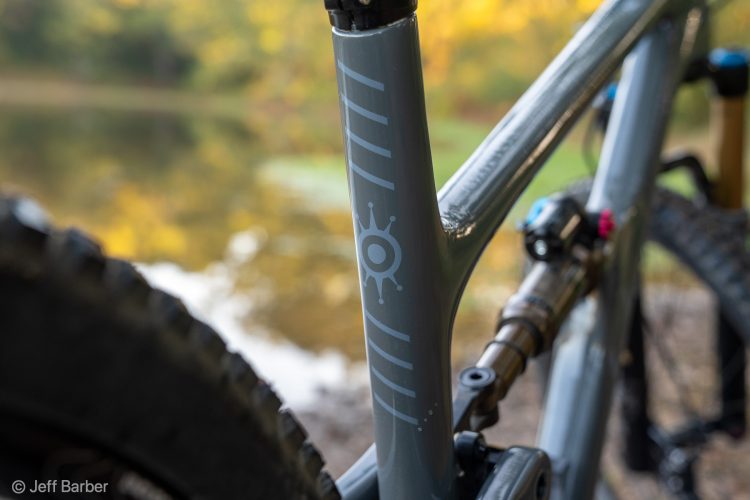
Yeah, yeah. We know. Gravel bikes are just 90s mountain bikes built to sell again. But when you look at new gravel bikes like the Ventum GS1, with its long reach and wheelbase, flip-chip, and SRAM UDH compatibility, this new 90s mountain bike sure has a lot of features in common with modern mountain bikes too.
What is Ventum Bikes?
First, let’s start off with who Ventum Bikes is, for those who haven’t heard of the brand. Ventum is a direct-to-consumer brand based in Utah that started out in 2015 as a “pet project among a professional athlete and engineers,” with a Z-shaped bike built for triathlons. Since then, they have released a UCI-ready road bike and in 2021, they released their first gravel bike, the GS1; a bike with comfort, versatility, and speed, says Ventum.
Just two years later, Ventum released the latest GS1. Recently at a gravel-oriented media camp I listened to a presentation on the new bike, and I couldn’t help but notice all the features that were borne from mountain bike technology.
Road bike technology seems to move at a snail’s pace, whereas mountain bikes are completely different than they were ten years ago. With gravel being such a new and hot category, the innovation seems ripe to move fast too.
Ventum’s new geometry theory has been given an acronym: POP, or Predictable Optimized Performance. It’s vague enough to mean a lot of things, but what they did do is extend the reach and wheelbase by 10mm, giving more stability to the gravel bike.
The GS1 is no mountain bike, but the numbers are pretty progressive. On the size medium I rode, the reach was 384mm (plus a 90mm stem, more later), a 1,024mm wheelbase, a 70° HTA, and a 72.5° STA.
When Ventum updated the GS1, they also gave it increased tire clearance, up to 700×48. Like mountain bikes, there are a few offshoots and sects in the gravel bike category, whether geared toward rugged bikepacking and underbiking on singletrack or taking on long-distance rides and races. I found this geared toward the latter, with narrower tire clearance, a stiff frame, and fewer accessory mounts than some others.
The GS1 also has a flip-chip and this one is in the fork axle and can be set to a 45mm or 50mm offset, giving it a sharper or a more stable steering feel. Ventum also gave the bike a SRAM UDH, which is a relatively new thing for gravel bikes. Hordes of brands have been switching their rear triangles over to adapt their mountain bikes to SRAM UDH for simpler compatibility and so it can adopt the latest SRAM Transmission. While this drivetrain is geared toward mountain bikes currently, it seems that SRAM would eventually have an answer for their gravel and road drivetrains, and because they don’t have to worry about impacts to the derailleur as much as mountain bikes do, gravel and road direct mount drivetrains feel a little more practical too.
Ventum sells the bike in a few configurations, from a $2,600 frameset to a complete SRAM Rival XPLR AXS build for $4,000, to the high end SRAM RED AXS build at $7,200.
Ride impressions
I put about 90 miles on the GS1 over a few days in Patagonia, Arizona. It wasn’t a long time to spend with a gravel bike, but it was enough to get a feel for what I liked about the bike. We’ll have a story on Patagonia soon. Turns out, it’s a pretty remarkable place to get some gravel and base miles in during shoulder season.
My first ride out on the GS1 was on a 50+ mile day where we skirted the Mexico border for a little, before steering back to Patagonia, which is an hour outside of Tucson. We started the ride with a long, bumpy climb. The GS1 is light, stiff, and responsive, three characteristics that stand out on a grave bike made for racing.
I felt a bit stretched out on the size medium and eventually scooted my saddle forward which helped. GS1 buyers can choose their stem length on select builds, but the shortest length stem available is still 90mm. With the increased reach and a longer stem, it was more front center than I preferred and it took a little extra power for me to get up some bumpy climbs.
The bike is notably stiff too and it can be felt over choppy dirt. This surely helps with power delivery and pedaling response, and I’d say it wasn’t as noticeable in the attack positions on descents where I could soak up some of the bumps more, but it was another marker that the GS1 likes long, steady, smooth(er) dirt than it does technical.
Where the bike did shine was on fast, rolling gravel descents. I assume this is related to its stable reach and wheelbase and its stiffness, but on our second day, we had a series of downhills with some chop and a little bit of tech and the GS1 held its speed and line admirably, feeling damn near unshakeable at speed down a bumpy dirt road.
Pros and cons of the Ventum GS1
Pros
- Fast and responsive ride
- Fairly affordable considering its competitors
- Good build options and can get either 1x or 2x
Cons
- Not the most compliant
- No fork mounts for would-be bikepackers
- May be too long for some riders
Closing thoughts
The Ventum GS1 is built for speed more than it is for functionality, though it has plenty of that too. Put more clearly, if long gravel rides are your draw more than bikepacking or drop bar singletrack attacks, then the GS1 is a fast and responsive ride with an appetite for speed and the geometry to carry it.
- Price: Builds start at $4,000
- Buy from ventumracing.com





















0 Comments